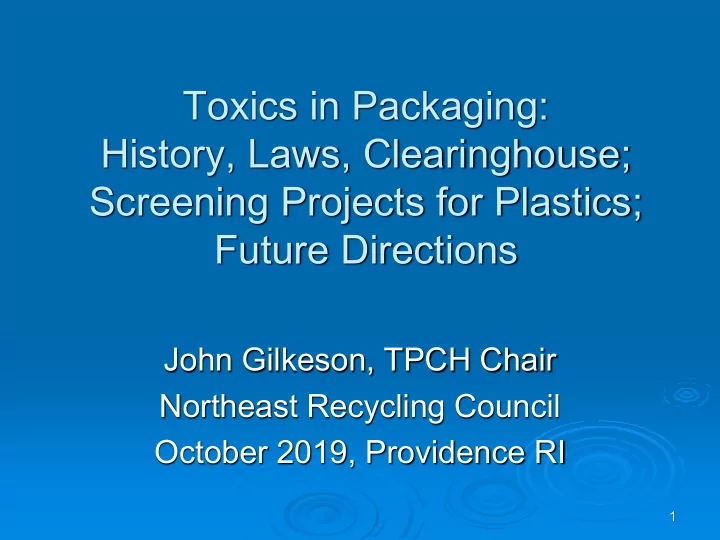

Toxics in Packaging: History, Laws, Clearinghouse; Screening Projects for Plastics; Future Directions John Gilkeson, TPCH Chair Northeast Recycling Council October 2019, Providence RI 1
2
The Garbage Barge 3
CONEG SRC Coalition of Northeastern Governors Source Reduction Council 4
Packaging! Packaging is one-third of the waste stream Most packaging is a single-use product Packaging is a strong candidate for recycling Packaging can contain toxics that impact waste, recycling, health 5
Toxics in Packaging! Lead Cadmium Mercury Hexavalent Chromium 6
Model Toxics in Pkg. Law Prohibits intentional introduction of any amount of the four regulated metals Limits incidental presence of the four metals to 100 ppm (0.01%) total concentration Applies to finished packaging and each individual packaging component Limited exemptions available initially, e.g., recycled content, certain reusable packaging Model approved by CONEG Governors Jan. 3, 1990; enacted in Maine April 17 and New Hampshire April 19, 1990 7
State enactment of TP laws 1990: ME, NH, WI, IA, CT, NY, VT, RI 1991: MN, WA 1992: NJ, GA, MD, IL 1993: FL, MO 1994: VA, PA 2003: CA 8
How do the laws work? Creates supply chain responsibility Producer companies self-certify based on: analytic tests supplier certification Provide Certificate of Compliance to customers (downstream producers), and states on request Most laws provide state with authority to levy monetary penalties against producers and distributors of both packaging and products 9
Success Stories Lead foil wine bottle wrappers (not addressed by FDA as food contact issue) Major manufacturer: cadmium pigment in yellow plastic container Lead solder in non-food cans (e.g., paint) Electronics and batteries in product packaging and displays Lead and cadmium in flexible plastic film 10
members/non-members/no law 11
TPCH State & industry/association members Maintains/Updates the model law Coordinates implementation of state laws for consistency and efficiency Single point of contact for companies (save companies time) Packaging screening projects 12
Screening Projects/Publications 2006-2007: Screened 355 pkgs; 26/44 PVC failed (60%) 19 Cd only 5 Cd and Pb 2 Pb only 13 film plastic failed 12 Pb (2 at 10,000 ppm) 1 Cd 13
Screening Projects/Publications 2009: Screened 409 packages 39/71 PVC failed (55%) 31 Cd only 8 Cd and Pb 3 film plastic failed, with lead colorant 7 ink on plastic (film and rigid) failed, with lead in inks 14
2011: Laboratory Round Robin Testing: Assessing Performance in Measuring Toxics in Packaging – 16% of testing for Pb and Cd > 25% off 2012: Testing of PVC packaging from discount retail chains 24/61 failed (39%) 23 Cd only 1 Cd and Pb metal parts also failed 919 ppm lead in zipper pull! 15
2012: Screening of Inks & Colorants in plastic bags used for shopping/mailing; screened 125 bags, 3 failed for Lead Colorants at 10,000 ppm (1%), for Yellow and Red 16
2015: 21/109 (19%) products found with PVC packaging that contains Cadmium; no Lead Includes five suppliers to one major retailer Home furnishings, housewares, pet toy and chew packaging made overseas Companies pulled significant inventory from stores/distribution (180k pkgs) Inventory can go to non-member states 17
TPCH Non-compliance Actions Confirm results with sample from 2 nd state Confirm with lab analysis in some cases TPCH letter to product mfr & retailer: Recall non-compliant pkgs from stores and distribution chain in TPCH member states, or Provide lab analysis demonstrating compliance of pkg on shelf in TPCH states this may result in ‘golden sample’ problem Request proper disposal of non-compliant pkg TPCH cannot block sale in non-TPCH states 18
Lead in wine bottles 2013 to 2016, TPCH found elevated lead levels in green wine bottles from Argentina (Malbec!) and Italy A few bottles > 1000 ppm Sources of lead unknown, CRT glass is a candidate Some TPCH states may distribute/sell wine: NH, IA 19
Additional Toxics in Law? State members are evaluating new chemicals and criteria for inclusion in TP Model Legislation, state adoption Washington Leg. amended TP law in 2018 Food pkg: direct contact, fiber or plant based Food pkg with added PFAS chemicals may not be sold effective 1/1/22 State agency must study and report on PFAS alternatives by 1/1/2020 20
New Toxic Substances Maine Leg. amended TP law in 2019 Food pkg: direct food contact, any material Food pkg with added phthalates may not be sold after 1/1/2022 ME DEP may by rule prohibit sale of food pkg with added PFAS chemicals after determining that feasible alternatives are available; 1/1/2022 or 2 years after alternatives determination; other conditions apply 21
Early review of add’l toxics 1994 Evaluation Report: Develop ‘Toxicity Protocol’ to guide inclusion of additional toxics 1998 Evaluation Report: TPCH needs to identify a scientific, peer reviewed toxics protocol… NJ and NY laws include criteria for inclusion of additional toxic substances 22
New York example of criteria …determination of whether the ingredient presents…an unreasonable risk to health or the environment, based upon a recognized risk assessment protocol [accounting for] the magnitude and severity of the harm against the benefits of the substance…to society as well as the availability of substitutes for the substance…and other adverse effects which such proposed action to eliminate such ingredient may have on society. 23
Pollution Prevention as a nonpartisan solution for toxics THE MAKING OF A CONSERVATIVE ENVIRONMENTALIST With Reflections on Government, Industry, Scientists, the Media, Education, Economic Growth, the Public, the Great Lakes, Activists, and the Sunsetting of Toxic Chemicals (1995) 24
www.toxicsinpackaging.org Melissa Walsh Innes Program Manager (802) 254-8911 info@toxicsinpackaging.org Chair: John Gilkeson, MN PCA john.gilkeson@state.mn.us 25
Recommend
More recommend